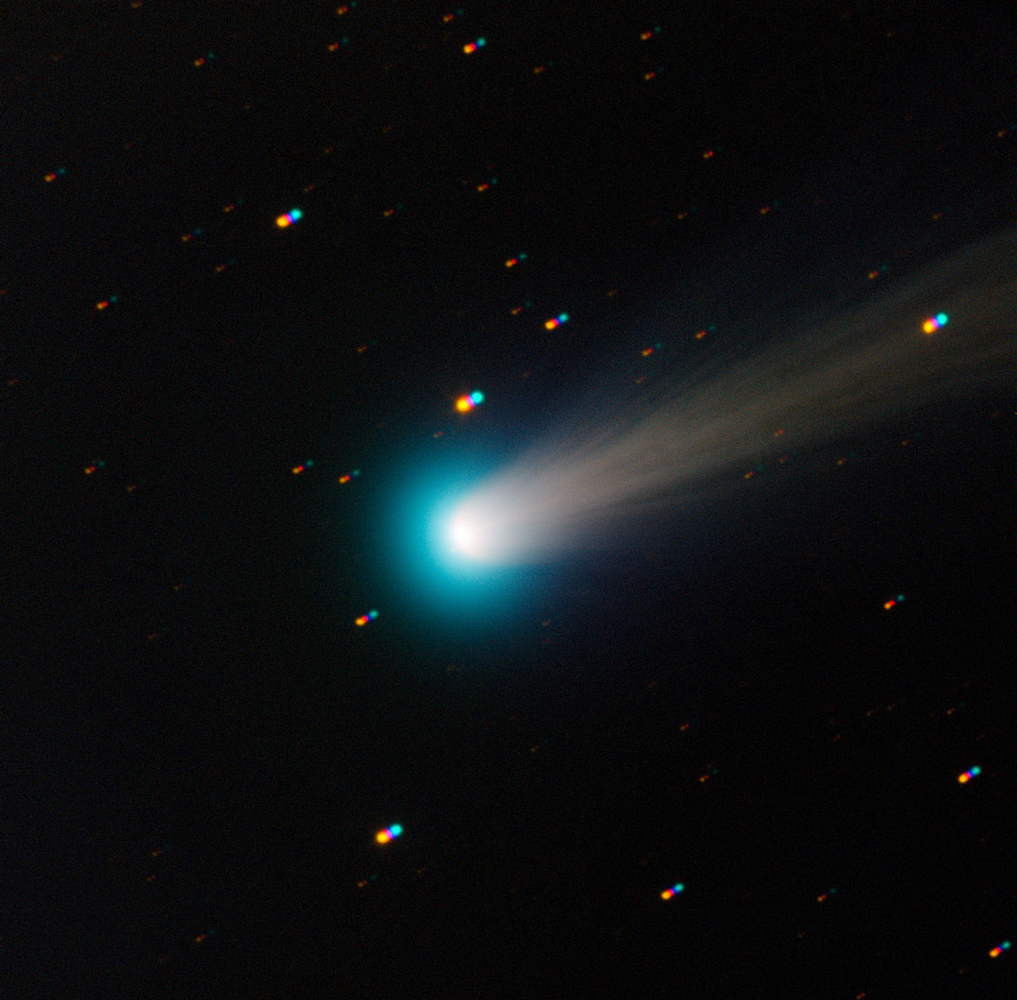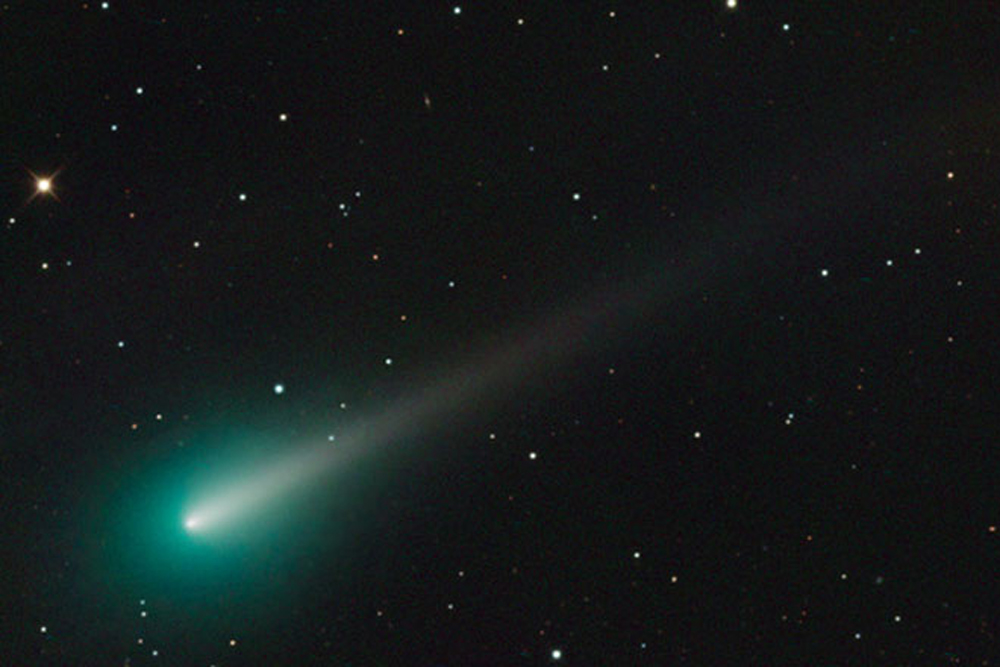Comet ISON: The Tricky Sungrazing Comet
Comet ISON was a sungrazing comet that was expected to put on a spectacular show in Earth's sky in late 2013. However, shortly after rounding the sun's far side on Nov. 28 (U.S. Thanksgiving), the comet faded, torn apart by the star's immense gravity.
ISON's behavior shortly after the close pass confused astronomers because it appeared brighter than what one would expect of a comet that had just broken up. It was later determined, however, that the increased activity was a trick of orbital dynamics.
In recent years, ISON has been cited as an example of the challenges of comet prediction. It's hard to say how bright a comet will be or when they will appear because their paths and behavior are still poorly understood.
ISON's unusually bright appearance before breaking up has some astronomers curious about its origins. One group of astronomers have speculated that ISON may have originated from outside of our solar system, making it similar to 'Oumuamua, an object that sped nearby our sun in 2017.
Discovery and naming
The comet was named after a telescope for the International Scientific Optical Network (ISON). Two Russian amateur astronomers, Vitali Nevski and Artyom Novichonok, spotted the comet in photographs taken by an ISON telescope in September 2012.
Traditionally, comets are named after the people who find them, such as Shoemaker-Levy 9 that crashed into Jupiter in 1994, or Hale-Bopp that brightened Northern Hemisphere skies in 1997.
Comet ISON, however, is part of a newer trend that sees the name of the comet after the project rather than the individuals who discovered it. This means that several comets could have the same name, leading to confusion. However, every comet also has a name assigned to it by the International Astronomical Union (IAU) that includes features such as the year of discovery. ISON's official name is Comet C/2012 S1.

Similar orbit to 1680 'Great Comet'
At the time of its discovery in late September 2012, Comet ISON was about 625 million miles (1 billion km) from Earth in the constellation of Cancer.
At 584 million miles (940 million km) from the sun, the comet was shining at magnitude 18.8 on a scale used by astronomers to gauge how bright sky objects are. (Brighter objects have a lower number.) This is about 100,000 times fainter than what the naked eye can see. [Gallery: Incredible Photos of Comet ISON]
"The most exciting aspect of this new comet concerns its preliminary orbit, which bears a striking resemblance to that of the 'Great Comet of 1680,'" wrote Space.com skywatching columnist Joe Rao.
"That comet put on a dazzling show; it was glimpsed in daylight and later, as it moved away from the sun, it threw off a brilliantly long tail that stretched up from the western twilight sky after sunset like a narrow searchlight beam for some 70 degrees of arc." (A person's clenched fist, held at arm’s length, covers roughly 10 degrees of sky.)
When the comet was still a long ways from Earth, in February 2013, NASA's Deep Impact spacecraft took a series of images of the comet. Deep Impact had snapped close-up pictures of two comets before — Tempel 1 and Hartley 2 — but the astronomers were fascinated by how much activity was taking place on ISON despite its great distance from the sun.
"Preliminary results indicate that although the comet is still in the outer solar system, more than 474 million miles (763 million km) from the sun, it is already active. As of Jan. 18, the tail extending from ISON's nucleus was already more than 40,000 miles (64,400 km) long," NASA stated in a February 2013 press release.
Thanksgiving mystery
ISON's final pass near the sun became visible in images from the Solar and Heliospheric Observatory (SOHO), a spacecraft which was originally designed to watch the sun. Over the years SOHO has discovered thousands of sun-grazing comets. The SOHO images showed that shortly after ISON's close shave with the sun on Nov. 28, 2013, its appearance brightened considerably. This confounded astronomers who had previously declared the comet dead.
More tracking of the comet in the days afterward revealed a rapid fading, however, and by Dec. 11 astronomers confidently called the comet dead. The strange brightening likely was due to an orbital dynamics phenomenon, said Geraint Jones of University College London at the time.
As the comet approached the sun, its fragment cloud was pulled out considerably, with the pieces closest to the sun moving faster than those far behind. After the comet dimmed, it then brightened up briefly when the pieces clumped together again after passing the sun. ISON's death in the SOHO images is still one of the more famous moments in the spacecraft's multi-decade history.

Astronomers noted that ISON likely fell apart due to its small size; its nucleus was between 330 feet and 3,300 feet (100 to 10,000 meters), according to observations from NASA's Mars Reconnaissance Orbiter.
"It was probably smaller than maybe 600 meters [in] diameter," said Alfred McEwen of the University of Arizona, principal investigator of MRO's HiRISE camera, at the time. "And from past sungrazing comets, those smaller than about half a kilometer, they don't survive."
In October 2014, two Lowell Observatory scientists — Matthew Knight and David Schleicher — published their findings from ISON observations. They concluded that the nucleus had a "significant mass loss" before Nov. 1, 2013, that “catastrophically weakened the nucleus prior to perihelion.” The paper was published in The Astronomical Journal.
More recently, astronomers have been looking at other methods to better predict comet brightness. One idea is to include observations from amateurs, who in recent years have gained access to extremely high-resolution photography and video. There are also studies of comets from up close, when spacecraft can reach them, which helps scientists learn about comet outgassing and their paths through space.
Additional resources:
- NASA's timeline of Comet ISON's journey.
- One-page overview on How NASA Space Assets Observe Comet ISON.
- More about Comet ISON from the Chandra X-Ray Observatory.
Join our Space Forums to keep talking space on the latest missions, night sky and more! And if you have a news tip, correction or comment, let us know at: community@space.com.
Get the Space.com Newsletter
Breaking space news, the latest updates on rocket launches, skywatching events and more!

Elizabeth Howell (she/her), Ph.D., was a staff writer in the spaceflight channel between 2022 and 2024 specializing in Canadian space news. She was contributing writer for Space.com for 10 years from 2012 to 2024. Elizabeth's reporting includes multiple exclusives with the White House, leading world coverage about a lost-and-found space tomato on the International Space Station, witnessing five human spaceflight launches on two continents, flying parabolic, working inside a spacesuit, and participating in a simulated Mars mission. Her latest book, "Why Am I Taller?" (ECW Press, 2022) is co-written with astronaut Dave Williams.










